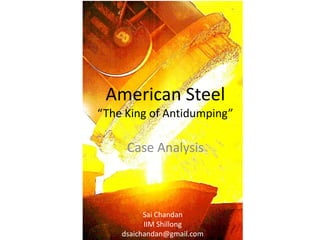
Anti Dumping Case
- 1. American Steel “The King of Antidumping” Case Analysis Sai Chandan IIM Shillong dsaichandan@gmail.com
- 2. The Players Foreign Country Domestic Country (US) Domestic Company Foreign Company
- 3. SWOT – Foreign Company • =>Competitive Pricing => Low priced Raw materials Strength • =>Support from National Governments => Technology • => Short term strategy Weakness • => US Companies dependency on Raw Steel Slabs, Immune Opportunities to anti-dumping => Opening up New Market • => High antidumping duties (up to 369%) leading to market Threat wipe-out
- 4. SWOT – Domestic Company • => Cooperative US Trade Laws => Lobbying Strength • => Poor decisions by managers => Lagging Innovation Weakness • => Uncompetitive High Wages • => Win back market share => Foreign companies’ price Opportunities sensitivity to Antidumping case suits • => Loss of World Market Share => Monopoly Threat
- 5. SWOT - Countries Domestic Country Foreign Country • Competitive industry • Legislation powers • WTO directives Strength Strength • Weak domestic companies • Vulnerability to their legislation Weakness • WTO directives Weakness • Can influence decision making by • Self reliance Opportunities threatening trade strains Opportunities • Monopoly of foreign player • Effect of counter dumping measures on domestic business Threat • Retaliation by the country Threat
- 6. Data Average GDP Steel applied Growth Filed AD Exports, import tariff rate, x Year Cases Affirmative '0000 T rate, x 10 10 1992 89 38 39.32 69.1 34 1993 36 11 39.42 67.3 29 1994 59 29 46.09 70 41 1995 18 9 31.13 61.4 25 1996 13 9 50.78 59.3 38 1997 23 14 42.25 59.5 45 1998 33 22 90.05 60 44 1999 50 20 98.58 52.6 49 2000 35 18 73.75 51.7 42 2001 92 40 62.17 50.6 11 2002 35 12 67.72 52.3 18
- 7. Correlation Antidumping 120 100 98.58 Filed AD Cases 92 89 90.05 80 Affirmative 73.75 69.1 70 67.3 67.72 61.4 62.17 Steel Exports, '0000 T 60 59 59.3 59.5 60 52.6 51.7 52.3 50.78 50 50.6 49 46.09 45 44 Average applied 41 42.25 42 40 39.32 39.42 40 import tariff rate, x 38 38 10 36 35 35 34 33 31.13 29 29 GDP Growth rate x 10 25 23 22 20 20 18 18 18 13 14 11 11 12 9 9 0 1 2 3 4 5 6 7 8 9 10 11
- 8. Recommendations Domestic Company Import activity is on a rise - File as many AD’s as possible. Attempt to upgrade the competitiveness. Foreign Company Adjust price in domestic market Show restraint - long term strategy – Cartels Make JVs, Alliances with domestic competitors. Exploit Raw Steel Slabs dependency- bundling products
- 9. Recommendations Domestic Government Choose between domestic (read self sufficiency) and foreign (read competitiveness), favoring domestic. Don’t deter foreign companies. Utilization of duty funds in same industry. Foreign Country Constantly put the domestic country under pressure by retaliation tactics Use WTO regulations as deterrents
- 10. Learning Genuine Antidumping Cases
- 11. References • http://data.worldbank.org/indicator/NY.GDP.MKTP.KD. ZG?page=3 • Exploring the patterns and determinants of U.S. antidumping actions against Latin American imports, 1980-2004, Robert M. Feinberg • http://www.nationsencyclopedia.com/WorldStats/UNC TAD-import-rates-other-goods.html • Bea.gov • The Rise of U.S. Antidumping Activity in Historical Perspective - Douglas A. Irwin • And of course “Google” and “Wikipedia”
Editor's Notes
- Domestic CompanyFile as many Anti-Dumping suits as possible when the import activity is on a rise.Simultaneously, make attempts to upgrade the competitiveness by analyzing the competitor strengthsForeign CompanyAdjust price in domestic marketShould show restraint to control quantity supplied and thereby profit opportunities in view of long term strategy as the current activities can trigger anti-dumping protestsMake joint ventures, alliances with local competitors.Exploit the dependency on Raw Steel Slabs by bundling products
- Domestic GovernmentSince Govt. need to choose between domestic (read self sufficiency) and foreign (read competitiveness), a balance need to be achieved carefully. (Assumption: Country has enough resources to possess comparative advantage of production.)Their action should marginally favor domestic industries while satisfying WTO regulations. Anti-dumping measures significantly strains trade ties between the countries.When an import duty is being levied, direct the earned money to uplift, upgrade the technology of that industry and increase its competitiveness.Import duty should not be in a way that it deters the company on a whole. It should be beneficial for both countries. To achieve this supply demand analysis of its home country + export costs need to be studied.Foreign CountryConstantly put the domestic country under pressure by retaliation tacticsUse WTO regulations ass deterrents